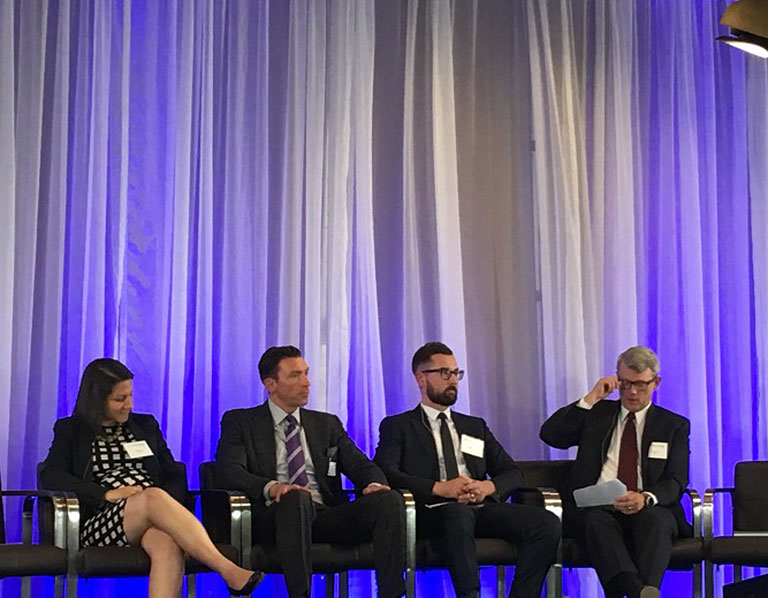NREL to Helm Laboratory Consortium Focused on Vehicle Connectivity and Automation

Gearhart (far right) moderates a panel discussion about new mobility and intelligent transportation with NREL partners (left to right) Lauren Isaac of EasyMile, Jarrett Wendt of Panasonic Enterprise Solutions, and Wes Maurer of Colorado Department of Transportation. Photo by Anya Breitenbach, NREL
Self-driving cars are at the bleeding edge of transportation innovation, but little is known about how they might impact energy demands. The U.S. Department of Energy's (DOE's) National Renewable Energy Laboratory (NREL) has been a driving force behind DOE's Systems and Modeling for Accelerated Research in Transportation (SMART) Mobility initiative—which encompasses research addressing vehicle connectivity and automation, integrated multi-modal transportation systems, behavioral and decision science, urban science, and vehicles and infrastructure—since its inception. In September, NREL's Chris Gearhart was officially appointed chair of DOE's SMART Mobility Laboratory Consortium steering committee.
"This started out a few years ago as a blue sky concept for the lab and DOE," says Gearhart, director of NREL's Transportation & Hydrogen Systems Center, who has been involved in all stages of SMART Mobility planning. "It's been gratifying to play a role in shepherding along the transformation from big idea to concrete research activity."
Input from NREL and other consortium members helped formulate the SMART Mobility vision, convene collaborative partners, and launch research activity—which this year influenced DOE's establishment of the new Energy Efficient Mobility Systems (EEMS) Program to encourage a maximum-mobility, minimum-energy future with automated, connected, efficient, and/or shared transportation systems. Other SMART Mobility Laboratory Consortium partners are Argonne, Idaho, Lawrence-Berkeley, and Oak Ridge National Laboratories.
NREL's involvement in DOE's EEMS Program, SMART Mobility initiative, and the Smart Cities Challenge is closely tied to the laboratory's Sustainable Mobility initiative, which approaches transportation as a network of travelers, services, and environments (rather than just vehicles and roads) using connectivity and automation to optimize mobility and significantly reduce related energy consumption.
"When you combine vehicle automation with connectivity and integrated systems, there is the potential for amazing synergy that can dramatically expand mobility, save money, reduce emissions, save lives, and reshape the urban environment," says Gearhart.
Other NREL Mobility Systems projects include:
- The DOE/U.S. Department of Transportation Smart Cities Challenge, advising Columbus, Ohio, in implementing a $50 million plan combining self-driving shuttles, rapid transit, and data analytics
- The Connected Traveler Project, investigating the effects that incentives and real-time feedback have on travel decisions
- The Colorado Department of Transportation (DOT) RoadX Program, evaluating how hypothetical fast charging networks could meet potential demands of increased electric vehicle ownership
- Collaboration with the I-95 Corridor Coalition, developing nationwide datasets reflecting real-time traffic volume.
Learn more about NREL's transportation research.
Last Updated May 28, 2025
